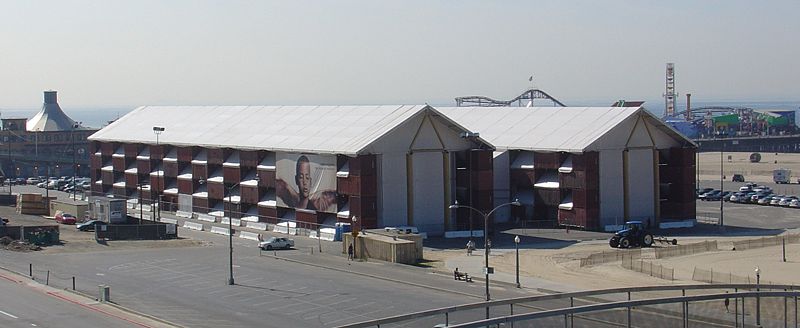Photo: Normadic Museum in Santa Monica
Heidi Zuckerman Jacobson, Director and Chief Curator of the Aspen Art Museum (AAM), announced today the selection of Shigeru Ban Architects (SBA) to design a new 30,000 square-foot facility for the AAM. This will be Ban’s premier museum design in the U.S. SBA was the unanimous choice of the Aspen Art Museum’s Architect Selection Committee, which includes: Frances Dittmer, Chair, and Secretary of AAM’s Board of Trustees; Nancy Magoon, President of the Board of Trustees; AAM Board Members Larry Marx and Gayle Stoffel; and, AAM National Council members Stefan T. Edlis and Diane Halle. The entire cost of designing, building, and operating the new Aspen Art Museum facility will be 100% supported by private funds from AAM museum donors.The intended site of the new Aspen Art Museum is part of the Zupancis-Galena (ZG) parcel in the core of Aspen at East Main Street and South Galena, pending the final approval of the Aspen City Council.
Of the selection, Jacobson comments: “For thirty years the Aspen Art Museum has been integral to Aspen’s unique identity. Among our most important institutional goals is to provide an unprecedented venue for the presentation of contemporary art—a non-collecting institution (kunsthalle) where audiences can discuss, experience, and learn about art, culture, and society. Shigeru Ban Architects assures Aspen an architecturally appropriate, environmentally sound, and culturally significant venue for art in the core of Aspen, and a vital arts space worthy of both Aspen’s important cultural history and its promising future within the national and international art community.”
Frances Dittmer adds: “As Chair of the Committee, I am thrilled to be part of this announcement of our selection of Shigeru Ban Architects as principal architect and designer for the new Aspen Art Museum. In our search, we felt that it was vital that the prospective architect not only understand the standards and expectations we have for the future home of our institution, but also its importance to Aspen. Ban’s work stood out as a clear, enthusiastic, and unanimous choice. His designs show a profound sensitivity in creating spaces that resonate in relationship to their environs and the environment itself. His visionary choices of materials and their inspired uses infuse each project with a unique presence and balance in relation to their surroundings. I have every confidence that Shigeru Ban’s design for the new AAM building will be an inspirational response to the needs and desires of the museum and the community. It will also offer a truly unprecedented venue for experiencing contemporary art.”
Shigeru Ban is critically heralded for his innovative approaches to environmentally sound architecture. Of his practice Ban states: “Innovative structures take on organic forms that originate both from ideas of construction as well as nature. My architectural practice is about people’s emotional connection to the buildings they occupy, and I strive for a unified relationship between the structure and the landscape. Because of the importance of architecture and landscape being one, designing the Aspen Art Museum is a very exciting opportunity to create a harmony between architecture and Aspen’s surrounding beauty, while also responding to the need for a design that inspires dialogue between artwork, the audience, and the space itself.”
Shigeru Ban and Shigeru Ban Architects (SBA)
Chief architect and founder, Shigeru Ban, was born in Tokyo in 1957. Ban attended The Southern California Institute of Architecture and later the Cooper Union School of Architecture in the mid seventies and eighties. In 1985, he returned to Tokyo to open Shigeru Ban Architects. Ban has received more than
35 awards for his inspiring contributions to the architecture and design world, including the MIPIM Awards in 2007, where he won 1st prize for residential developments. In 2002 he won the “Best House in The World” Prize for his revolutionary Naked House, at the World Architecture Awards, and, in 2001 Time Magazine named him “Innovator of the Year.”
Ban is widely known for structures that incorporate paper, and for his singular development of paper tube technology. His dual concerns and commitments to both environmental and humanitarian efforts drove him to design and implement temporary shelters for victims of Kobe, Japan’s 1995 Great Hanshin earthquake, as well as offer his services to the United Nations in aid of the victims of 1999’s Rwandan earthquake.
Ban is an honored member of the architecture world and has received two honorary fellowships from The Royal Architectural Institute of Canada and The American Institute of Architects.
Shigeru Ban Architects (SBA) was founded with the focus on the exploration of unique design materials and structures. Through its innovative designs SBA strives to pioneer inventive solutions to push the boundaries of conventional building processes. The firm has produced over 100 works of industrial design and architecture in its 23 years of groundbreaking design, contributing to the advancement of not only commercial ventures but also high-end residential designs. Upon extensive research and experimentation, SBA has developed numerous structural systems and construction methods utilizing various materials
such as basket-woven bamboo dome roof systems, wood as a fire-rated material, and bookshelves used as a main building structure. Notable international projects include: Centre Pompidou –Metz, Metz, France (2009); Metal Shutter House, New York, (2008); Takatori Church, Kobe, Japan (2007); Nomadic Museums: Tokyo (2007), Santa Monica (2006), New York (2005); and, Paper Tube Structures for Refugees in Rwanda (1999).
Referring to Ban as “The Accidental Environmentalist”, New York Times Chief Art Critic and Columnist Michael Kimmelman recently described him as, “An heir to Buckminster Fuller and Oscar Niemeyer, to Japanese traditional architecture and to Alvar Aalto, he is an old-school Modernist with a poet’s touch and an engineer’s inventiveness.”




